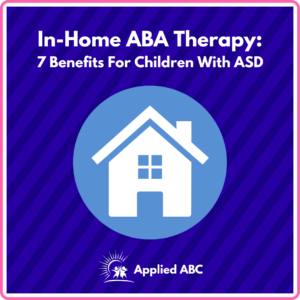 When a child is diagnosed with Autism Spectrum Disorder (ASD), many parents navigate a world of therapeutic options. One of the most effective interventions is Applied Behavior Analysis therapy (ABA). While ABA can be implemented in various settings, many families find that in-home therapy offers unique advantages.
When a child is diagnosed with Autism Spectrum Disorder (ASD), many parents navigate a world of therapeutic options. One of the most effective interventions is Applied Behavior Analysis therapy (ABA). While ABA can be implemented in various settings, many families find that in-home therapy offers unique advantages.
In-home ABA therapy provides a personalized and familiar environment for children with ASD, and we’ll cover seven key benefits for why families might choose therapy at home.
Personalized a Naturalistic Environment
Children often learn best in their everyday surroundings. In-home ABA allows therapists to work in familiar settings, enabling children to generalize skills effectively. For instance, a child learning communication skills at home is more likely to use them with family members during daily routines.
Enhanced Family Involvement
In-home therapy directly involves family members in the process. Parents can observe sessions, ask questions, and learn strategies for use throughout the day. This activity involvement increases the likelihood that therapeutic gains are maintained outside of therapy hours, as parents can reinforce their child’s skills.
Family participation ensures that interventions are customized to the family’s needs. Therapists can help identify triggers for behaviors and implement tailored solutions in real time.
Flexibility In Scheduling & Delivery
Unlike center-based therapy, which often requires commuting, in-home ABA offers greater flexibility. This reduces the stress of balancing therapy with daily obligations, as therapists can work around the family’s schedule. Regular sessions without logistical challenges promote long term success.
Minimizing Sensory Overload
Children with autism often experience sensory sensitivities that can be triggered by unfamiliar environments. In-home therapy allows the child to remain in a comfortable setting, reducing anxiety and distractions, which supports better focus and engagement.
Holistic Learning Opportunities
Home is where children learn essential life skills, such as dressing and interacting with siblings. In-home ABA teaches these skills in relevant contexts. A therapist working in the home can integrate lessons into daily routines, making therapy both functional and comprehensive.
For example, during snack time, a therapist can encourage communication skills by prompting the child to ask for more food. Reinforcing social language skills in a meaningful way.
Addressing Service Discontinuation
A significant challenge to ABA therapy is service discontinuation. In a study by Kristen R. Choi, et al., findings indicate that many children do not receive the full benefits of ABA, despite being referred. In the study, 13% of the children surveyed never began therapy after referral. Less than half of the children who began ABA treatment remained in therapy for two years.
Factors such as family structure and previous history of special education impact treatment duration, but in-home therapy can address barriers by providing more support and consistency for those who need it, making it easy to maintain ongoing treatment.
Effectiveness of In-Home Therapy
The findings from a study by Dennis R. Dixon, et al. underscore the effectiveness of in-home ABA therapy. Children receiving services in their home environment demonstrated significant gains in adaptive behaviors. This suggests that in-home therapy not only enhances engagement but also allows for interventions tailored to each child’s unique needs. By combining the comfort of home with targeted therapeutic strategies, families can maximize the potential benefits of ABA therapy, promoting lasting positive outcomes for their children.
Flexible ABA For the Full Effect
For many families, in-home ABA therapy offers a comprehensive, flexible, and family-centered approach that can significantly improve a child’s development. By providing therapy in a familiar environment, children can learn skills that generalize into their everyday interactions while parents gain valuable tools to support their child’s progress. As the studies by Choi, Dixon, and their colleagues suggest, addressing barriers to consistent treatment is essential to realizing the full benefits of ABA therapy. In-home therapy may be an effective solution to enhance engagement and reduce dropout rates.
Works Cited
Choi, K.R. et al. (2022) Patient outcomes after applied behavior analysis for autism spectrum disorder, Journal of developmental and behavioral pediatrics : JDBP. Available at: https://www.ncbi.nlm.nih.gov/pmc/articles/PMC8702444/ (Accessed: 01 October 2024).
Dixon, D.R. et al. (2016) A program evaluation of home and center-based treatment for autism spectrum disorder, Behavior analysis in practice. Available at: https://www.ncbi.nlm.nih.gov/pmc/articles/PMC5621997/ (Accessed: 01 October 2024).



